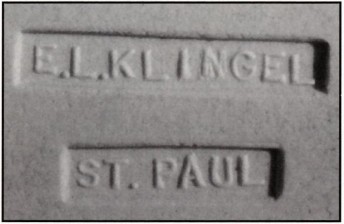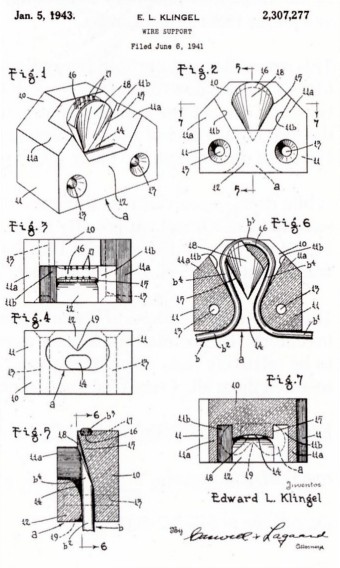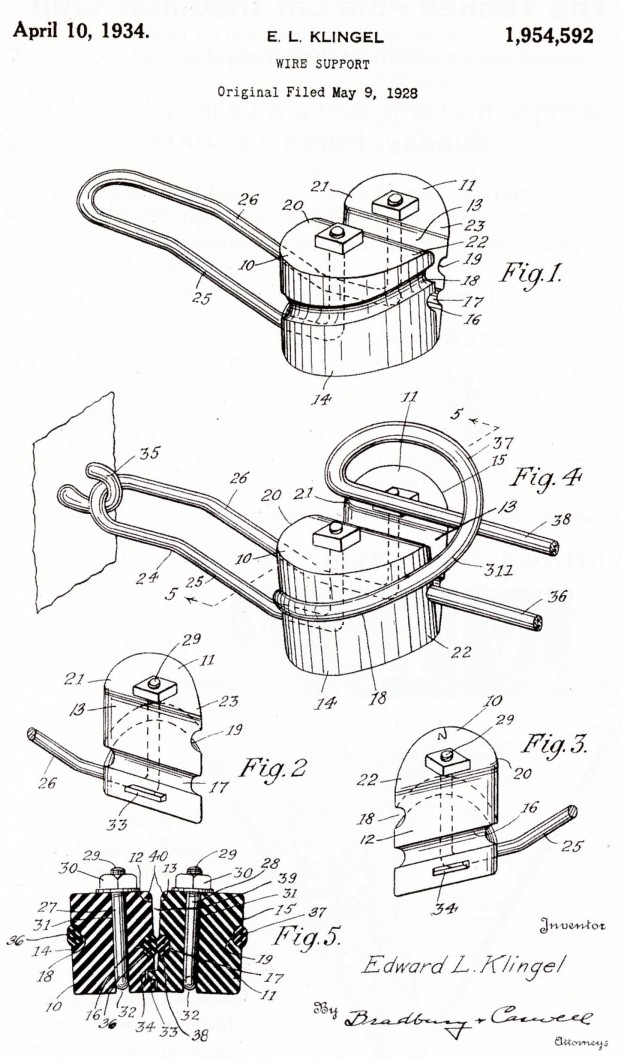The Hunt For Edward Klingel
By Rick Soller
Reprinted from "Crown Jewels of the Wire", February 2007, page 3
Recently while looking over my shelves of insulators, I picked up the odd
porcelain piece pictured here. My records indicate I bought the piece in 2000
from Doug Williams on eBay for about $10. Recess-embossed on the unglazed bottom
is a block of text that reads, "E.L. KLINGEL." Another
recessed-embossed block of text under this reads, "ST. PAUL." Embossed
on the top is "PARALLEL / KNOB / PAT APPL FOR". After closer
inspection a few days later in better light, I also noticed an M in a triangle.
This Triangle-M marking indicates the piece was made by Illinois Electric
Porcelain in Macomb.


Edward L. Klingel of St. Paul, Minnesota received patent 2,307,277 on January
5, 1943 for this insulator that would avoid the use of a tie wire for telephone
drop-wires. The drawing in the patent is nearly identical to the actual white
glazed porcelain insulator. Two things are missing from the patent: the
dimensions and molding details.

The wire support is 1.75 inches tall, 2-1 /8 inches deep, and 2-5/8 inches
wide. One interesting difference in the insulator not revealed in the patent
drawing is how the insulator was manufactured. Because of the complexity of the
piece (i.e., holes running different directions, undercuts and
wire-gripping-ribs), the insulator is made in two pieces (top and bottom) and
glaze welded together.
For many inventors, insulator collectors know no more than this kind of
information so I am happy to report some additional details I have uncovered
about Mr. Klingel. The Minnesota Historical Society website (mnhs.org), for
example, lists the following:
Name: Klingel, Edward Louis
Born: November 22, 1883 out of state
Mothers
Maiden Name: Dippold
Death: July 14, 1961
County of Death: Ramsey |
Both the Minneapolis Morning Tribune and the St. Paul Pioneer Press ran
obituaries on July 16, shortly after his death. The Tribune gave me his home
address on 964 Ohio St., W. in St. Paul; that services were at Unity (Unitarian)
church; a list of relatives and that the internment was to be at Forest Lawn
Cemetery. From the Pioneer Press, I learned he was a telephone engineer who
headed the E.L. Klingel Co., 128 Concord St., which was founded in 1919. The
Pioneer Press went on to indicate "He was active in telephone research and
equipment 61 years and held several patents relating to the telephone industry.
Mr. Klingel was a member of the Minnesota Telephone association and life member
of the U.S. Independent Telephone Pioneer association."
This research was done in Minneapolis while heading to a swap meet in
Oronoco, MN so I had time to locate his grave at the Forest Lawn Cemetery. I
found directions and drove there to find that he had been cremated and his ashes
spread over the Memorial Pond of the cemetery. I took some photographs of the
Memorial Pond but didn't think too many people would be interested in seeing
them here.
While doing research in Washington, DC in August, I checked on the other
patents that Mr. Klingel supposedly held. I found two. United States letters
patent #1,954,592 was issued on April 10, 1934 for a "Wire Support."
Patent #2,510,182 was issued on June 6, 1950 for another "Wire
Support."
There are over a thousand patents related to insulators with almost that many
inventors. This research took place over a four month period which I considered
to be relatively fast. Even at this rate, I estimate it would take me 200 years
to research them all. I sure could use some help. Interested?
Editor's Note: Rick Soller call be contacted at the following email
address:
com574@clcillinois.edu
Or, call him at 847-782-8602

| 